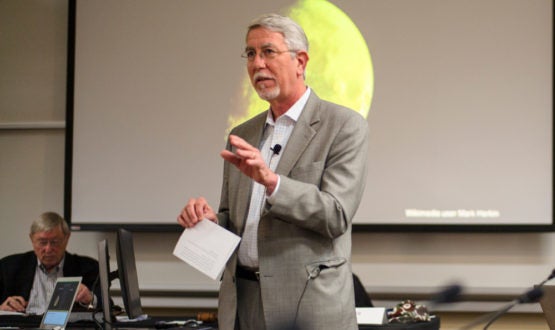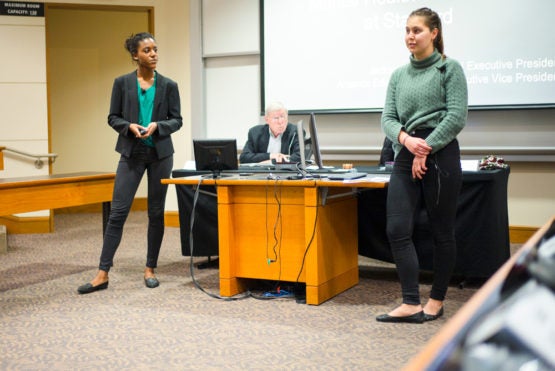Faculty Senate discusses campus climate and immigration, classroom upgrades, student mental health and well-being
The speakers at the Dec. 1 meeting included Stanford President Marc Tessier-Lavigne; Richard Holeton, senior director of learning environments; Tom Black, university registrar; Jackson Beard, president of the Associated Students of Stanford University; and Amanda Edelman, vice president of the ASSU.

University Registrar Tom Black addressing the Faculty Senate on the need for updated classrooms. (Image credit: Aaron Kehoe)
The Faculty Senate discussed a wide variety of issues at its Thursday meeting, including the university’s commitment to supporting undocumented students, the need for more “flexible classrooms” that promote interactive, collaborative and experiential learning, and student mental health and well-being.
Speaking at the Dec. 1 meeting, President Marc Tessier-Lavigne reaffirmed Stanford’s commitment to free expression, diversity and inclusion, saying “intolerance of others based on their background, identity or views is antithetical to our values.”
Tessier-Lavigne said Stanford will continue to provide services and support to students without regard to their immigration status, referring to the Nov. 19 Stanford Statement on Campus Climate and Immigration, which is posted on the university’s website.
“We emphasized that the university supports the ability of undocumented students to continue their studies at Stanford and earn a degree here,” he said.
“We reiterated our support for the DREAM Act for undocumented students, and for DACA, an executive action of the government that has allowed many undocumented immigrants who arrived in the United States as children to continue their education without fear of imminent deportation.”
He said those are long-standing positions of the university and are based on its core values.
Tessier-Lavigne said the Stanford Department of Public Safety, which is part of the Santa Clara County Sheriff’s Office, does not enforce federal laws solely related to immigration status.
Tessier-Lavigne said Stanford signed a public letter in support of DACA with other universities on Nov. 21, even though the university has a practice of not adding its name to petitions or statements when Stanford hasn’t been involved in crafting them.
“It’s important to emphasize that we made these statements as a reaffirmation of our fundamental values,” he said. “As you know, Stanford does not typically issue statements taking positions on political or policy issues, and we engage only when the subject matter directly relates to our ability to carry out our core missions of education, research and clinical care.”
In response to a question from a faculty member regarding the University of California system, which recently announced the steps it would take to protect its students who came into the country illegally, Tessier-Lavigne said UC and Stanford share the same values.
Provost John Etchemendy noted that Stanford treats undocumented students as domestic students, assessing their applications under the same need-blind admission policy it uses for citizens of the United States.
Flexible classrooms
In other business, Richard Holeton, senior director of learning environments, told the Faculty Senate that Stanford needs more “flexible classrooms” that promote interactive, collaborative and experiential learning to support modern, research-based teaching methods increasingly used by faculty.
Holeton, along with University Registrar Tom Black, suggested that Stanford needs more flexible classrooms especially for larger classes (50 to 150 students).
They said that more Stanford faculty and departments are integrating active-learning pedagogies, sometimes in combination with traditional modes like lectures, and these evolving teaching practices often require new classroom designs.
Holeton, who oversees the Learning Environments Group in the Office of the Vice Provost for Teaching and Learning (VPTL), said Stanford knows how to design flexible classrooms, pointing to classrooms in Wallenberg Hall and Lathrop Library.
In Wallenberg and Lathrop, the classrooms are designed to allow information and communication to flow in multiple directions.
The rooms have robust power and networking capabilities, and the ability to display data and video. Students can easily configure tables and chairs for group work. The classrooms have a variety of sophisticated learning technologies, including interactive whiteboards, collaboration stations and portable whiteboards for group work, and some have videoconferencing and recording equipment.
Holeton and Black said Stanford faces two major constraints in increasing the number of flexible classrooms on campus: a limited budget that supports only modest equipment changes without architectural modification, and a lack of space in existing classrooms.
“Modern flexible classrooms require significantly more square feet per person, about 35 square feet per person, than nearly all Stanford classrooms have available,” Holeton said, adding that the university’s traditional large classrooms provide only 8 to 17 square feet per student.
“Given the budget and space constraints, we can make only incremental progress in meeting the needs that faculty have identified,” Holeton said.

ASSU leadership Jackson Beard and Amanda Edelman discussing student mental health with the Faculty Senate on Thursday. (Image credit: Aaron Kehoe)
Black suggested that a “moon shot” approach would be to construct a dedicated classroom building designed to accommodate evolving teaching needs.
Holeton said VPTL and the Registrar’s Office, which schedules classes and classrooms, are committed to working with faculty to chart the future evolution of instructional spaces. Holeton and Black wrote a 7-page report, The Evolution of Stanford’s Classrooms, which is available on the Faculty Senate website.
Student mental health and well-being
In the final presentation of the meeting, Jackson Beard, president of the Associated Students of Stanford University (ASSU), and Amanda Edelman, ASSU vice president, told the senate that mental health and well-being is a critical issue of importance in student life.
Beard said mental health and well-being is a core issue for them as student leaders, primarily because it’s a universal issue that affects students of all types.
“This is the one binding issue on our campus,” she said.
Edelman said the ASSU is focused on several mental health and well-being initiatives this year, including redesigning the website of the Stanford Wellness Network; addressing concerns about wait times for counseling appointments at Vaden Health Center; and administering a survey to gauge the campus climate on mental health.
Edelman said one way that faculty could help students would be to identify and offer support to students who seem to be struggling with coursework or any other issues.
“We’re not advocating for leniency across the board, but for being empathetic as to what students may be going through and aware of some warning signs,” she said. “If a normally well-performing student starts to miss class, starts to be late to class, understand that there may be some underlying issues. And a small empathetic gesture from a professor or a respected authority figure goes a very long way in those instances.”
The minutes of the Dec. 1 senate meeting, including the discussions that followed the reports, will be available soon on the senate’s website.
